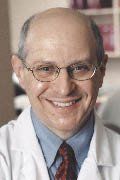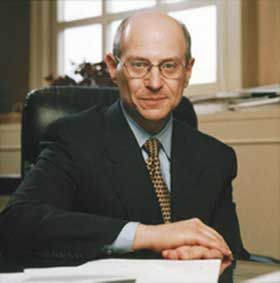Dr. Larry Norton & the Case of the Recurring Mass
There is a large musical instrument, a vibraphone, occupying a corner of Dr. Larry Norton’s office, but it doesn’t seem out of place. He is a serious musician, so serious in fact that in his youth he thought hard about a career in music.
ABSTRACT: One case led him to oncology; another, to his famous hypothesis.
There is a large musical instrument, a vibraphone, occupying a corner of Dr. Larry Norton’s office, but it doesn’t seem out of place. He is a serious musician, so serious in fact that in his youth he thought hard about a career in music.

Larry Norton, MD, grew up in suburban Long Island, at the edge of New York City; a subway ride took him downtown to Greenwich Village. It was the 1960s, and "The Village" was the epicenter of New York's counterculture. McDougal and Bleecker streets were the crossroads he frequented. He remembers a young Bob Dylan performing at Cafe Wha?, so fresh on the scene he was still learning his trademark harmonica riffs.
Larry Norton, MD, grew up in suburban Long Island, at the edge of New York City; a subway ride took him downtown to Greenwich Village. It was the 1960s, and “The Village” was the epicenter of New York’s counterculture. McDougal and Bleecker streets were the crossroads he frequented. He remembers a young Bob Dylan performing at Cafe Wha?, so fresh on the scene he was still learning his trademark harmonica riffs.
“It was an incredibly interesting time. All about breaking boundaries, experimenting with new ideas,” Dr. Norton told ONI during a recent visit to his office at Memorial Sloan-Kettering Cancer Center, where he is deputy physician-in-chief and director of Breast Cancer Programs.
Dr. Norton lifted a soft mallet and struck one of the vibraphone’s aluminum bars, delivering a short note. “I wasn’t sure what I wanted to do with my life when I left college,” he said. He toyed with the idea of staying in New York City, but went instead to the University of Rochester to study music.
In those days, he said, Rochester was a hotbed of musical inventiveness. “But after about a year there, I began to question whether I should pursue a career in music. I didn’t know what else I wanted to do, but I was always drawn to science.”
A Word of Inspiration
One afternoon, he met a friend, Ronald Blum, MD, on the steps of the University of Rochester Rush Rhees library. (Dr. Blum later became a prominent oncologist, and is currently at Beth Israel Medical Center, New York.)
“I told Ron that I was questioning my decision to become a professional musician,” Dr. Norton said.
The year before, Blum said he had spent “the best summer of his life” at the Roswell Park Memorial Institute (now Roswell Park Cancer Institute) working with an inspirational cancer researcher.
“The word ‘inspirational’ caught me immediately,” Dr. Norton said. He hopped a bus to Roswell Park in Buffalo. “I interviewed with the same researcher, William Regelson, MD, who was a giant in the early days of oncology. He asked tough insightful questions, but I heard in his voice what a lot of the great musicians of that era had preached: Let’s not get stuck in the past; be radical and inventive.”
That summer with Regelson was eye-opening, whetting Larry Norton’s appetite for science; the following summer was career molding. Dr. Regelson had moved to the Medical College of Virginia. Larry Norton followed his mentor there the next summer, working as a laboratory assistant and doing rounds. While he was there, a patient was admitted with a huge gynecologic neoplasm that had actually eroded out into the skin.
“It was a horrible-looking cancer. She was treated with methotrexate, not a great drug by today’s standard. But this tumor just melted away, like someone had waved a magic wand,” he said, adding that it was largely this case, bordering on miraculous, that sparked his interest in oncology.
“The trajectory of my medical history has been greatly influenced by single cases,” said Dr. Norton, who, despite being known for innovative scientific research, considers himself a clinician at heart.
After receiving his MD from the College of Physicians and Surgeons, Columbia University, he trained in internal medicine at the Albert Einstein College of Medicine.
He then served as a clinical associate and investigator at the NCI. That was when another case led to a theory largely inspired by Benjamin Gompertz, a self-educated mathematician known for Gompertz’s law of mortality, a mathematical model he published in 1825. The model holds that growth rates of populations are exponential at early stages of development and slower at later stages.


Dr. Norton, who identifies himself as a biomathematician, said he had all the measurements of the patient’s tumor.
“So I looked at the math, trying to understand the exponential mathematical model we used to describe tumor growth. I discovered that the mathematical model we used to tailor our treatment didn’t make sense. It worked in mice, but not in this individual case.”
Modeling Animal Data
Dr. Norton did some reading, coming across the work of Anna K. Laird who had shown that an equation called the Gompertz Curve accurately predicted tumor growth in mice. NCI offered Dr. Norton access to enormous amounts of animal data and contractors.
“I modeled animal data against the Gompertz Curve and showed that not only did the tumor growth fit the curve, but there was a law that connected the parameters of the Gompertz equation,” he said.
Some 150 years after Gompertz developed his law of mortality, Dr. Norton showed that tumors follow Gompertzian growth functions-small tumors grow faster than larger ones.
He and his NCI colleague, Richard Simon, DSc, developed the Norton–Simon hypothesis, which suggests that tumors given less time to regrow between treatments are more likely to be destroyed. It flew in the face of orthodoxy, “and I spent the next couple of decades of my life working on it. Moving step-by-step through the system in order to get enough people excited about my ideas to actually test them,” Dr. Norton said.
Because of his tenacious year-after-year effort to advance an unpopular theory, the Norton-Simon hypothesis eventually won acceptance and led to trials of dose-dense chemotherapy that have changed our approach to treating breast cancer.
An Anti-Math Bias?
Toward the end of the conversation, Dr. Norton voiced his frustration with the continuing reluctance of some in the oncology community to reevaluate traditional dosing schedules. He thinks, in part, it might be the result of an unwarranted bias against math.
“They’re looking for new molecules, but having new molecules is just the first step. You have to know how to use them at the right dosing schedule,” he said. “If Einstein were a biologist living today, nobody would pay attention to his ideas because they’re all mathematical.”
Asked if he’s optimistic about our ability to eventually cure cancer, Dr. Norton answered unequivocally, “We will absolutely turn cancer into a treatable chronic disease, much like tuberculosis.”
He also expressed profound concern, bordering on anger, over a government that has shifted its monetary priorities away from cancer research.
But in the next breath, Dr. Norton expressed his deep faith in America, in her endless resolve and possibilities.
Past and Future Meet at 64th Street
“My forebears were prisoners of the Czar. They escaped Eastern Europe, came here, and made a life out of a dream,” he said.
His mother, who died last year, was an immigrant child in New York City’s teeming Lower East Side. “In the summer, they trucked the poor kids from the inner city up to the Catskills to escape the disease in the sweltering tenements,” Dr. Norton said.
He pulled out an artist’s rendition of MSKCC’s new breast cancer facility rising above 64th Street, the one he’ll soon head. Pointing at it, he said, “She used to pass right there on the truck, admonishing people on the street who poked fun at the poor kids riding in the back of a truck.”
Dr. Norton’s many honors include ASCO’s highest award, the David A. Karnofsky Memorial Award, in 2004. He served as ASCO president in 2001-2002, served on the NCI’s National Cancer Advisory Board from 1998-2004, and has been scientific director of The Breast Cancer Research Foundation since its inception in 1993. He is the first incumbent of the Norna S. Sarofim Chair in Clinical Oncology at MSKCC.
Dr. Norton is now working on another barrier-breaking concept that will challenge our current understanding of the underlying features of metastases, hopefully broadening our ability to treat disease that is seldom cured.
Dr. Larry Norton said he loves what he does. At MSKCC, he works within the paper-thin walls separating the healthy, the sick, and the dying by employing a multidisciplinary approach: He’s a biomathematician, a writer, a musician, a clinical innovator, but more than anything, he’s a clinician, a healer of women with breast cancer.
Newsletter
Stay up to date on recent advances in the multidisciplinary approach to cancer.